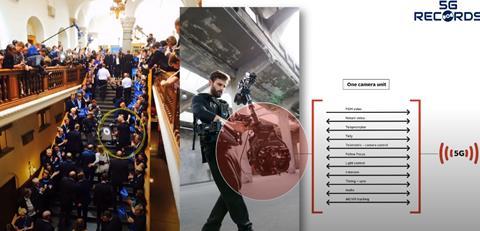The migration from 4G to 5G is the topic of intense debate from many perspectives, but it was also the fulcrum for discussion in the most recent IBC365 webinar, 5G for live contribution.

With a panel of considerable expertise in the field, from ITN’s Richie Roser, Head of Field Operations & Connectivity, to Flemish national television and radio broadcaster VRT’s Jonathan De Bolster and Morten Brandstrup, Head of news technology, TV 2 Denmark, the stage was set for an exciting blend of innovation and technical expertise, tempered with substantial of pragmatism around the value of 5G in broadcast.
4G is still a key technology
Jonathan De Bolster, System Expert, ENG & transmission at VRT set the tone early on: “The 5G aspects are very important,” he said. “But we still will have 4G for a long time. Maybe four decades or even longer… The added value of 5G will be in the guarantees. We will mostly use that in mobile setups like cycling races [and] music festivals when you are walking around. 5G will change the way we work. It’s not just a technology update like 4G +1. It will be an entire ecosystem and we will have to adapt as well.”
- Read more: 5G in broadcast - what, when, and how
An anecdote from Richie Roser illustrated a central challenge around 5G for live contribution, where recording the New Year ‘bongs’ of Big Ben with a mobile unit proved more challenging than expected - in spite of the usual crowds (and therefore local network contention), being more than a mile away.
“The local cell had absolutely loads of coverage. What we hadn’t accounted for was [that] down the line, the network was oversubscribed in that region [of central London]. So we suffered immense problems because of a bonded solution without being on a wired connection.”

Network slicing offers huge opportunity
Roser continued: “What 5G will give us - providing that operators can deliver upon it - is the business-to-business [and] the machine-to-machine network slicing that we don’t get with 4G today. So, we should be able to operate in a network slicing environment and have a [channel] dedicated to throughput or bandwidth and [be confident that] this channel would be unaffected by any domestic crowds.”
Network slicing is the facility in 5G NR that allows network operators to segment their network capacity, ensuring that essential services, or premium subscribers, can always use the level of connectivity they have agreed, irrespective of other users on the cell or wider network. However, while the concept and technical end of this is baked into 5G network hardware and software, the exact mechanisms available to broadcasters wishing to access it are still under development.
5G live with the TDF
‘Still under development’ might describe much of the 5G infrastructure. But as Morten Brandstrup pointed out, specific use cases in private 5G networks are already demonstrating the huge potential of 5G in a live broadcast environment.
Speaking of getting the best from mmWave, he said: “We use that for the Tour de France. The Tour de France [2022] took off in Copenhagen and we used that opportunity to have a camera mounted in one of the towers above the finish line, [capturing] the whole of the compound and the crowd.
- Read more: Tour de France 2022: Behind the scenes
“We have this millimetre wave pointing from the opposite side of the location and have a really good stable connection with high throughput. So that’s a nice way to extend a fibre connection into a 5G solution and just have your device and your camera and be able to [operate] remotely - something that will definitely have a great potential.”
Broadcast and the 5G business case
An interesting closing discussion switched the focus back to public networks, and the importance for broadcasters to collaborate and work with operators to ensure that the services needed for live contribution are developed from a business perspective. As Roser somewhat ruefully explained, there are parallels to be drawn with satellite capacity.
“The more frequency store, the more spectrum slicing they do, the slimmer your bandwidth will become. So we’re going to be fighting [for bandwidth] continuously. Just as with satellite capacity, the traditional broadcast medium, you’re fighting the ad hoc space. What was an abundance, you’re now competing with the ever increasing demand of fixed services, and you’re seeing a loss of the satellite capacity. I fear that by 2035-2040, the 5G network will have the same fate and that’s where we’ll be into 6G!”
From the discussion, the value of 5G for live is unassailable. Reduced production costs thanks to easier, more flexible camera signal transportation, along with specific, innovative use cases seem set to make the technology a no-brainer for many live scenarios. However, network rollout and the business case for the operators are both areas where more work is needed.
To get the full picture, the webinar 5G for live contribution is now available to watch for free.
























No comments yet